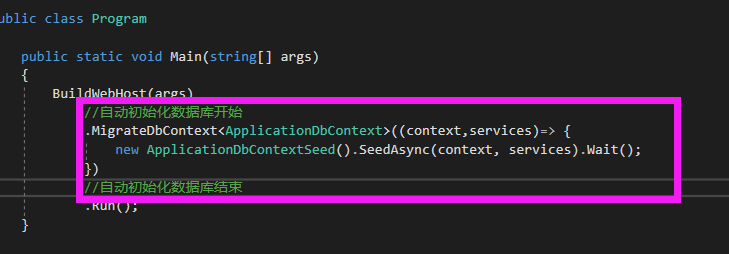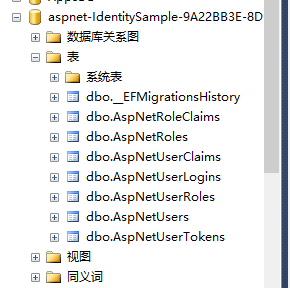前言
由于我们现在每次EF实体模型变化的时候每次都是手动更改,我们想通过代码的方式让他自动更新,或者程序启动的时候添加一些数据进去
DbContextSeed初始化
首先,在Data文件夹下添加一个ApplicationDbContextSeed.cs初始化类
using Microsoft.AspNetCore.Identity; using MvcCookieAuthSample.Models; using System; using System.Collections.Generic; using System.Linq; using System.Threading.Tasks; using Microsoft.Extensions.DependencyInjection; namespace MvcCookieAuthSample.Data { public class ApplicationDbContextSeed { private UserManager<ApplicationUser> _userManager; public async Task SeedAsync(ApplicationDbContext context, IServiceProvider services) { if (!context.Users.Any()) { _userManager = services.GetRequiredService<UserManager<ApplicationUser>>(); var defaultUser = new ApplicationUser { UserName="Administrator", Email="786744873@qq.com", NormalizedUserName="admin" }; var result= await _userManager.CreateAsync(defaultUser,"Password$123"); if (!result.Succeeded) { throw new Exception("初始默认用户失败"); } } } } }
那么如何调用呢?接下来我们写一个WebHost的扩展方法类WebHostMigrationExtensions.cs来调用ApplicationDbContextSeed方法
using Microsoft.AspNetCore.Hosting; using Microsoft.EntityFrameworkCore; using System; using System.Collections.Generic; using System.Linq; using System.Threading.Tasks; using Microsoft.Extensions.DependencyInjection; using Microsoft.Extensions.Logging; namespace MvcCookieAuthSample.Data { public static class WebHostMigrationExtensions { public static IWebHost MigrateDbContext<TContext>(this IWebHost host, Action<TContext, IServiceProvider> sedder) where TContext : DbContext { using (var scope=host.Services.CreateScope()) {//只在本区间内有效 var services = scope.ServiceProvider; var logger = services.GetRequiredService<ILogger<TContext>>(); var context = services.GetService<TContext>(); try { context.Database.Migrate(); sedder(context, services); logger.LogInformation($"执行DBContext {typeof(TContext).Name} seed执行成功"); } catch (Exception ex) { logger.LogError(ex, $"执行DBContext {typeof(TContext).Name} seed方法失败"); } } return host; } } }
那么我们程序启动的时候要怎调用呢?
要在Program.cs中执行

我们接下来把数据库删掉,然后启动程序运行一下

数据库已自动生成并插入数据